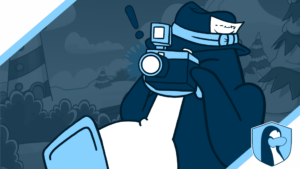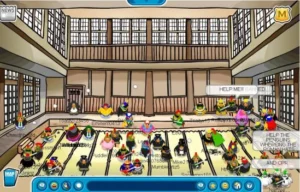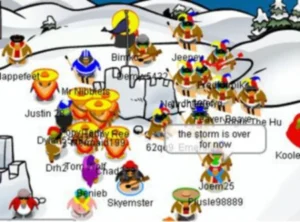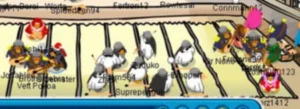World War II sparked a fierce and lasting conflict as armies rose up, forever changing the game’s landscape. In this edition of Picture Perfect, we will delve into the significant events that took place during World War II.

Designed by Cassie
Emergence of Armies
Before the rise of organized armies, Club Penguin’s environment was ruled by informal clans, identifiable only by their shared colors. These early clans—known largely as Red and Blue clans—lacked the rigid structure and strategy that would come to define subsequent armies. Players met largely for informal fun, their battles unplanned and disordered, motivated more by curiosity and confusion than by any strategic objective. However, in 2006, the culture on Club Penguin began to alter as the Miniclip Forums became the gathering grounds for more individuals. It was here that these rookie groups saw the potential for a new kind of group—one that could be led, organized, and ultimately feared.
In late September 2006, this vision was realized as the Army of Club Penguin was established by a player named Oagalthorp. The ACP immediately provided new levels of structure to Club Penguin warfare, with official uniforms, positions, and rules that attracted members eager to be part of something powerful. No longer merely a group of people donning different colors, ACP became a legitimate army with strategic goals and a united identity, provoking interest and concern across the Club Penguin community. Inspired by this achievement, other players tried to form their own armies, determined to undermine ACP’s authority and grab power for themselves. Among these opponents were the Romans, an ambitious force led by Explorer7777, who tried to carve out their spot in Club Penguin’s evolving geography.
The War and the Rise of Rivalries

The ACP and Romans fight in the Dojo, 2006
As the rivalry intensified, the Club Penguin community became immersed in a culture of competition and strategy. Fights stretched from Mammoth to the Dojo and Snow Forts, where armies showcased superiority. On the Miniclip Forums, ACP and the Romans recruited forces, declared victories, and called for reinforcements. Tensions grew when new factions, inspired by the ACP-Roman battle, joined the fray. Emerging groups like the Vikings, Pirates, and Nachos either sided with one of the main armies or sought their own place in the conflict. This expanded the battlefield, with shifting allegiances and new challenges emerging.

One of the few pictures of these battles taking place.
One of the most crucial moments in this fight was the Battle of the Igloo on October 13, 2006. This fight, skillfully planned and performed, would become one of the defining battles of World War II in Club Penguin history. At precisely 3 PM PST, ACP and the Romans clashed in a conflict that would test both armies’ strategy and commitment. The battle raged for over half an hour, with ACP ultimately declaring victory after forcing the Romans to retire. The Battle of the Igloo was a landmark incident, proving the force of organized warfare and unleashing a surge of new battles as other armies, realizing the stakes, joined the intensifying struggle for dominance.

LEGACY
CPA was profoundly impacted by World War II, with ranks, commands, and tactical approaches still influencing how players fight. The tactics and leadership philosophies established during this period served as the model for armies in the future. Beyond this battle, the leaders of the ACP and Romans left a lasting impact, with Oagalthorp and Explorer7777 being immortalized as legends. The foundations established during World War II were essential in determining the direction of Club Penguin’s virtual warfare when new armies and rivalries arose.
MtJordan II
Senior Reporter
[…] comparison, Nachos had a very different trajectory from AR. For example, Nachos defeated Ice Warriors for the first March […]